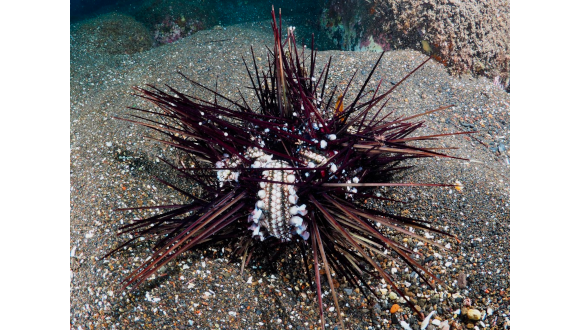TAU research reports deadly epidemic killed all black sea urchins in the Gulf of Eilat

Urchins considered a key species essential for the healthy functioning of coral reefs
Support this researchA series of new, disturbing studies from Tel Aviv University (TAU) reveal a deadly epidemic causing mass mortality of black sea urchins in the Mediterranean Sea and the Gulf of Eilat. The entire population of black sea urchins in Eilat was wiped out over a couple of months. Today no living black sea urchins have remained at the site, only skeletons.
The studies note that such extensive mortality is also occurring in other countries in the region, including Jordan, Egypt, Saudi Arabia, Greece, and Turkey.
The research was led by Dr. Omri Bronstein and PhD students Rotem Zirler, Lisa-Maria Schmidt, Gal Eviatar, and Lachan Roth from TAU’s School of Zoology at the Wise Faculty of Life Sciences and The Steinhardt Museum of Natural History. It was published on May 24, 2023, in Royal Society Open Science.
The researchers emphasize that sea urchins in general, and the long-spined Diadema setosum in particular, are considered key species essential for the healthy functioning of the coral reef.
The researchers assume that the source of the deadly epidemic is a pathogenic ciliate parasite that has spread from the Mediterranean to the Red Sea. An urgent report describing the current situation was submitted to the Israel Nature and Parks Authority, and emergency steps for protecting Israel’s coral reefs are now under consideration.
“At first we thought it was some kind of pollution or poisoning, or a local chemical spill, from the industry and hotels in the north of the Gulf of Eilat, but when we examined additional sites in Eilat, Jordan, and Sinai, we quickly realized that this was not a local incident,” Dr. Bronstein says. “All findings pointed to a rapidly spreading epidemic. Similar reports are coming in from colleagues in Saudi Arabia. Even sea urchins that we grow for research purposes in our aquariums at the Interuniversity Institute, and sea urchins at the Underwater Observatory Marine Park in Eilat, contracted the disease and died, probably because the pathogen got in through the pumping systems.
“It’s a fast and violent death: within just two days a healthy sea urchin becomes a skeleton with massive tissue loss. While some corpses are washed ashore, most sea urchins are devoured while they are dying and unable to defend themselves, which could speed up contagion by the fish who prey on them.”
The first reports on mass mortality reached Dr. Bronstein several months ago, from colleagues in Greece and Turkey, which the sea urchins had invaded, probably through the Suez Canal.
The mass mortality reminded the TAU researchers of one of the most famous and devastating events in the history of marine ecology: the disappearance of the sea urchins in the Caribbean. Until 1983 the Caribbean coral reef was a thriving tropical reef, quite similar to the coral reef in the Gulf of Eilat. Once the sea urchins disappeared, the algae multiplied without control, blocked the sunlight from reaching the corals, and the entire reef changed irreversibly, from a coral reef to an algae field.
“Last year the disease broke out again in the Caribbean, killing the surviving urchin populations and individuals,” says Dr. Bronstein. “Unlike past events, today we have the scientific and technological tools to analyze the forensic evidence. A group of researchers from Cornell University identified the cause of mortality in the Caribbean: a pathogenic ciliate parasite. The pathology observed in the sea urchins dying in Greece and Turkey is identical to the pathology in the Caribbean, and it’s also the pathology we see in the sea urchins dying here in the Red Sea.
“In my opinion we must urgently establish a broodstock population for these sea urchins, so that if needed, we will be able to return them to nature in the future,” Dr. Bronstein concludes. “Unlike the COVID-19 pandemic, we have no way of vaccinating or treating the sea urchins, and so we must focus all efforts on prevention. The window of opportunity for preserving a healthy population of this species in Eilat has already closed. If we want to establish a broodstock population, we must do it today, by preserving healthy individuals from the Israeli Mediterranean – before the disease, spreading from the north, reaches this area. This is a complex task, but it is absolutely necessary if we wish to ensure the survival of this unique species that is so critical to the future of coral reefs.”